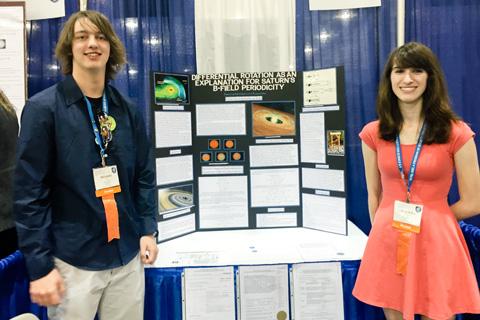Three Werner H. Kirsten student interns claimed awards at the 35th Annual Frederick County Science and Engineering Fair—and got a shot at the national competition—for imaginative projects that reached out to the rings of Saturn and down to the details of advanced cancer diagnostics.
Student intern Frederika Rentzeperis was one half of the team that took home the grand prize for a project focused on the magnetic field surrounding Saturn, while interns Carrie Pritt and Bohan Shan won first place in both the engineering design and computational biology and bioinformatics categories for building software to improve tumor diagnostics as well as a related web application.
The interns all earned recognition and an opportunity to present at the Intel International Science and Engineering Fair in Phoenix, Ariz.
Studying Astronomy During Study Breaks
Rentzeperis and her partner, Middletown High School senior Richard Derr, spent two years on their project, which was not conducted in an NCI laboratory. Instead, it was a hobby.
During her sophomore year, Rentzeperis examined her physics teacher’s unfinished graduate poster about an unexpected periodic motion of Saturn’s plasma sheet, a feature of the magnetic field surrounding the planet. The motion resembles the way in which a fabric sheet would “flap” as someone shakes it.
Rentzeperis was inspired to pick up where her teacher left off, working during her 90-minute study periods and staying after school, as well.
The project is an analysis of why Saturn’s magnetic field lines rip and leave ionized particles that directly hit the plasma sheet. A similar situation exists on the sun, where differential rotation causes a lot of tension in the magnetic field, leading to sun spots and rips at the sun’s surface. Rentzeperis and Derr hypothesized that, since there is differential rotation on the rings of Saturn, there could be a similar grappling between the planetary field and the rings’ fields, and that this could be a possible cause of the plasma sheet flapping.
The project has been entered in several science fairs, but each year, the data and new findings were updated. This year, Rentzeperis and Derr developed a model to show where the plasma sheet flapping could occur. When Rentzeperis found out they won the grand prize, she said, “we were very, very surprised—it was kind of crazy.”
Rentzeperis said the project was a combined effort and that Derr played a vital role in its development with his strong math background. Derr assisted by studying magnetohydrodynamics through various partial differential equations.
Rentzeperis and Derr eventually plan to use a system such as Mathematica to numerically solve their system of differential equations. A clear solution, which does not consist of many unsolved derivatives, will enable them to create a model of Saturn’s system and plug in data from the unmanned Saturn spaceship, Cassini, to check their hypothesis.
“I’m really excited [for Intel],” Rentzeperis said. “I think it’ll be a lot of fun.”
Rentzeperis’ interest in astronomy started from a young age when she began entering science fairs in fourth grade. Her first science experiments included wiring fruits to power a calculator and boiling cabbage to use as a pH indicator. Later on, she started reading astronomy articles and books by Stephen Hawking in her free time. She then went on to memorize all the masses of the periodic elements.
Rentzeperis is a WHK student intern studying limb and digit development under her mentor, Anna Trofka, Ph.D. She graduated from Middletown High School and will be attending Dartmouth University to study physics and neuroscience.
Programming a Clear View of Tumors
Pritt, the winner of the engineering design and computational biology and bioinformatics categories, spent the past year developing a computer program that identifies tumor size and coordinates using images. Fellow winner, Shan, worked on a web application to make the program more efficient and accessible. For the Frederick County Science and Engineering Fair, the team created a poster titled, “Interactive Cloud-based Tumor Recognition Software for Medical Analysis,” which earned several awards.
Pritt explained that they entered the science fair to give their year-long work exposure, to practice presenting, and to verify their understanding through preparation for the event. The partners said they were pleased their work was well-received and that several people who stopped by their booth were impressed.
One of the best comments they received was that their “project was meaningful and could save a lot of lives,” Shan said. “Many people were surprised that high school students could do this.”
Pritt and Shan were WHK student interns in the Advanced Biomedical Computing Center this past year and are continuing their work through the WHK Student Intern Program this summer. Pritt graduated high school as a home-schooled student and will be attending Princeton University this fall to major in mathematics. Shan graduated from Urbana High School and will be attending the University of Maryland, College Park to study computer engineering.


